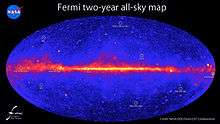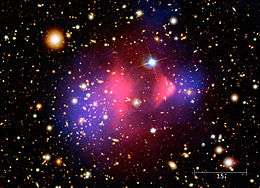Calorimetric Electron Telescope
| Organisation | Japan Aerospace Exploration Agency |
|---|---|
| Telescope style | space observatory, Gamma ray observatory |

The CALorimetric Electron Telescope (CALET) is a space telescope being mainly used to perform high precision observations of electrons and gamma rays. It tracks the trajectory of electrons, protons, nuclei, and gamma rays and measures their direction, charge and energy, which may help understand the nature of dark matter or nearby sources of high-energy particle acceleration.[2]
The mission was developed and sponsored by the Japan Aerospace Exploration Agency (JAXA), involving teams from Japan, Italy and USA. CALET launched aboard JAXA's H-II Transfer Vehicle Kounotori 5 (HTV-5) in August 2015 and was placed on the International Space Station's Japanese Kibo module.
Overview

CALET is an astrophysics mission that searches for signatures of dark matter and provides the highest energy direct measurements of the cosmic ray electron spectrum in order to observe discrete sources of high-energy particle acceleration in our local region of the galaxy.[4][5] The mission was developed and sponsored by the Japan Aerospace Exploration Agency (JAXA), involving teams from Japan, Italy and USA. It seeks to understand the mechanisms of particle acceleration and propagation of cosmic rays in the Milky Way galaxy, to identify their sources of acceleration, their elemental composition as a function of energy, and possibly to unveil the nature of dark matter.[2] Such sources seem to be able to accelerate particles to energies far higher than scientists can achieve on Earth using the largest accelerators. Understanding how nature does this is important to space travel and has possible applications here on Earth.[2] The CALET Principal Investigator is Shoji Torii from the Waseda University, Japan; John Wefel is the co-principal investigator for the US team; Pier S. Marrocchesi, is the co-investigator from the Italy team.
Unlike optical telescopes, CALET operates in a scanning mode. It records each cosmic ray event that enters its field of view and triggers its detectors to take measurements of the cosmic ray in the extremely high energy region of Tera electron volt (TeV, one trillion electron volts).[5] These measurements are recorded on the space station and sent to a ground station at Louisiana State University for analyses.[6] CALET may also yield evidence of rare interactions between matter and dark matter by working in synergy with the Alpha Magnetic Spectrometer (AMS) —also aboard the ISS— that is looking at positrons and antiprotons to identify dark matter.[2] Observation will be carried out for 2–5 years.[7]
CALET contains a subpayload CIRC (Compact Infrared Camera) to observe Earth surface, to detect forest fires.[8]
Objectives
The objectives are to understand the following:[9]
- origin and mechanisms of acceleration of high-energy cosmic rays and gamma rays
- propagation mechanism of cosmic rays throughout the galaxy
- identity of dark matter
As a cosmic ray observatory, CALET aims to clarify high energy space phenomena and dark matter from two perspectives; one is particle creation and annihilation in the field of particle physics (or nuclear physics) and the other is particle acceleration and propagation in the field of space physics.
See also
References
- ↑ "NASA - Fermi's Latest Gamma-ray Census Highlights Cosmic Mysteries". www.nasa.gov. Retrieved 2015-05-31.
- 1 2 3 4 Dunn, Andrea (9 October 2014). "Dark Matter and Particle Acceleration in Near Space". NASA News. Retrieved 2015-11-10.
- ↑ "Hubble Maps the Cosmic Web of "Clumpy" Dark Matter in 3-D" (Press release). NASA. 7 January 2007.
- ↑ "CALorimetric Electron Telescope (CALET) - at NASA". Japan Aerospace and Exploration Agency (JAXA). 27 August 2015. Retrieved 2015-11-10.
- 1 2 CALET aboard the ISS Kibo Started the First Direct Electron Observation in Tera Electron Volt Region. JAXA Press Release- October 22, 2015.
- ↑ CALET USA. Louisiana State University (2015).
- ↑ "CALorimetric Electron Telescope (CALET): Background". Japan Aerospace and Exploration Agency (JAXA). April 24, 2014. Retrieved 2015-11-10.
- ↑ "Compact Infrared Camera(CIRC)". JAXA. Retrieved November 19, 2015.
- ↑ "CALorimetric Electron Telescope (CALET): Background". Japan Aerospace and Exploration Agency (JAXA). April 24, 2014. Retrieved 2015-11-10.
External links
- "Status and performance of the Calorimetric Electron Telescope (CALET) on the International Space Station". (PDF) By Roberta Sparvoli.
- CALET brochure in English (PDF) at JAXA.
